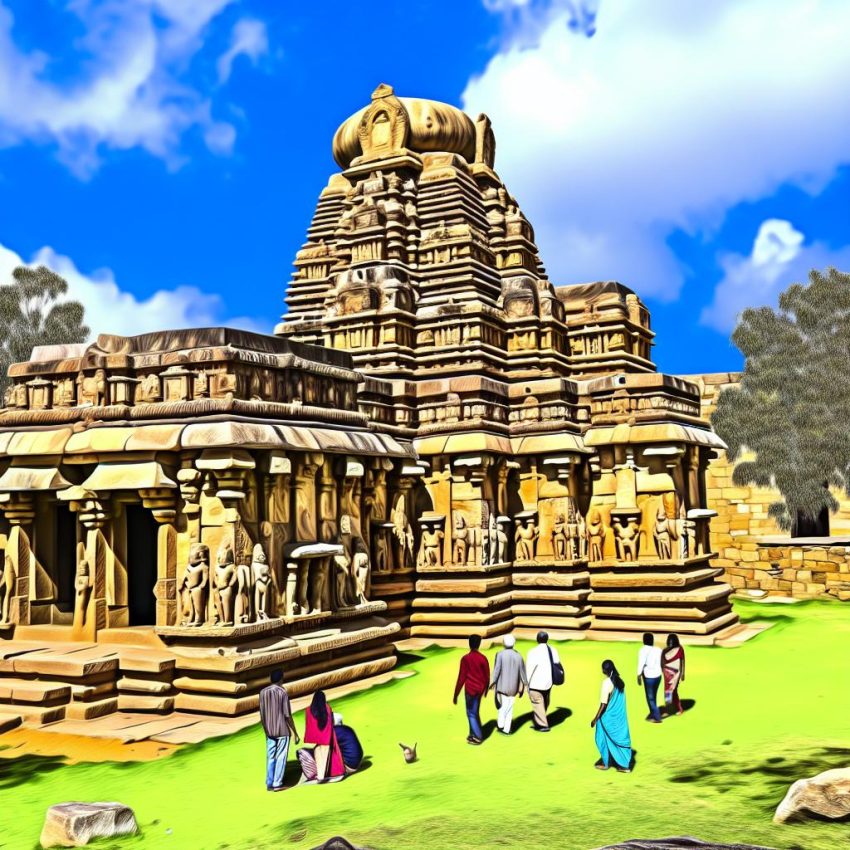Historical Significance of Aihole Temples
Aihole, located in the Bagalkot district of Karnataka, India, holds a distinguished place in the annals of Indian temple architecture. Known as the cradle of Hindu rock architecture, this village served as a vital experimentation ground for the master architects of the Chalukya dynasty. Here, the artistic genius of Indian craftsmen flourished, leading to the creation of diverse architectural styles that have influenced temple constructions for centuries.
Approximately dating back to the 5th century CE, the temples of Aihole are nestled along the banks of the picturesque Malaprabha River. This site comprises over 125 temples, presenting architectural styles that span several centuries. This range offers a fascinating insight into the evolution and diversity of Indian temple architecture.
Architectural Styles and Features
The architecture witnessed at Aihole is marked by an eclectic mix of Nagara and Dravidian styles. These structures mirror the transitional phase in Indian temple architecture, where craftsmen began to experiment with novel forms and styles. The diversity of designs observed is a testament to the artistic innovation that characterized this era.
One of the most noteworthy structures in Aihole is the Durga Temple. This temple is celebrated for its distinctive apsidal shape, which resembles a Buddhist Chaitya Hall. The intricate carvings adorning the Durga Temple vividly depict scenes from ancient Indian epics, offering a tangible connection to the mythological and cultural heritage of India.
Another architecturally significant temple in Aihole is the Lad Khan Temple. This temple demonstrates a more primitive architectural style, featuring a flat roof and a mandapa supported by sturdy columns. The temple’s design points toward the early exploration and adaptation of temple architecture in the region, providing a contrast to the more elaborate structures constructed in later periods.
Iconography and Artistic Details
The temples of Aihole are renowned for their elaborate iconography and artistic detail. Artists of the era meticulously carved scenes from the Ramayana and the Mahabharata, India’s revered epics. This iconography not only served a decorative purpose but also played an educational role, narrating the rich tapestry of myths, legends, and history to the people.
In addition to epic scenes, the temples feature a plethora of depictions of various Hindu deities and mythological figures. The precision and attention to detail in these carvings reflect the exceptionally skilled craftsmanship of the time. These artistic creations offer insights into the socio-religious practices and beliefs that were prevalent during the era in which they were carved.
Cultural and Religious Aspects
Beyond its architectural brilliance, Aihole held significant cultural and religious importance in its time. The village was not merely a hub of architectural innovation but also served as a center for spiritual and educational pursuits. Scholars from different regions of India congregated here, attracted by the village’s esteemed reputation as a beacon of learning and spiritual development.
The continuing evolution of architectural styles in Aihole also mirrors the changing religious practices and sociopolitical dynamics of the time. As religious fervor and practices transformed, so too did the architectural expressions found in Aihole, with each subsequent style adding layers of cultural context to the village’s temples. This transformation is illustrative of the dynamic nature of Indian architecture, where religion and art continually influenced each other.
Access and Visitor Information
Aihole is accessible by road and is a prominent stop on the heritage tours frequented by those exploring Karnataka’s rich historical tapestry. Given its historical and architectural significance, a visit to Aihole is an essential component of understanding the breadth of Chalukyan architectural achievements. It is often recommended that a visit to Aihole be combined with trips to other nearby historical sites such as Pattadakal and Badami. These sites together provide a more comprehensive appreciation of the Chalukyan contributions to Indian architecture.
When planning a visit to Aihole, it is advisable to carry a guidebook or consider hiring a knowledgeable local guide. Such resources can significantly enhance the experience by providing detailed context and historical narratives that illuminate the significance of each architectural masterpiece. This enriched understanding can offer visitors a deeper appreciation of Aihole’s role as a cornerstone in the history of Indian temple architecture.
